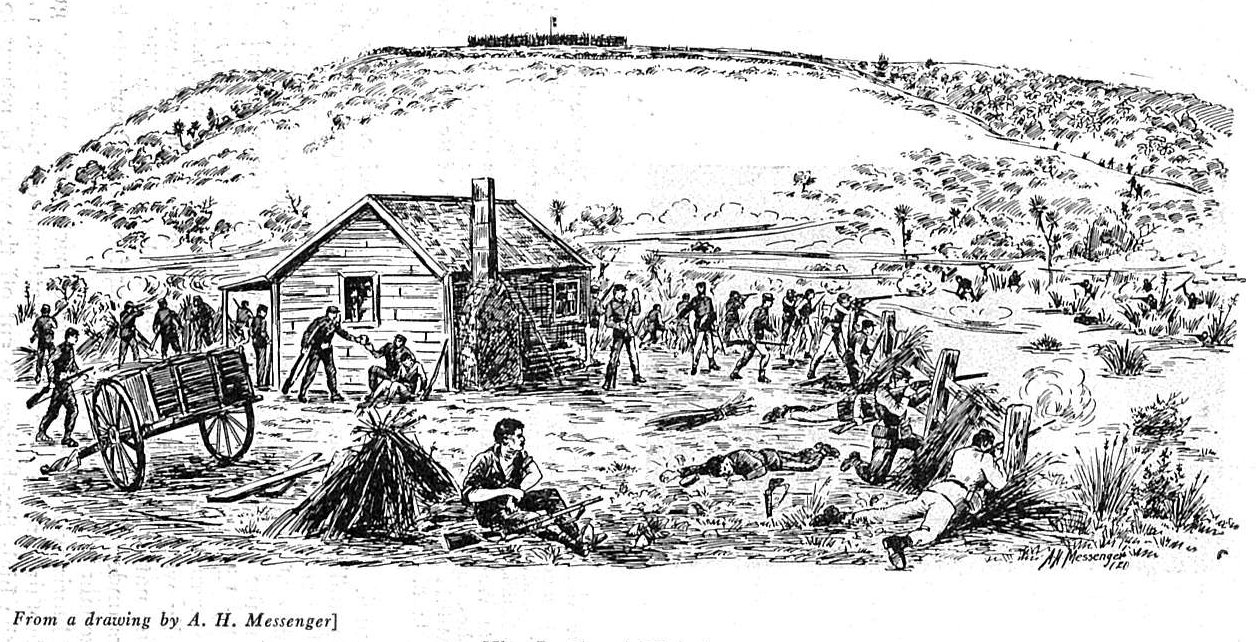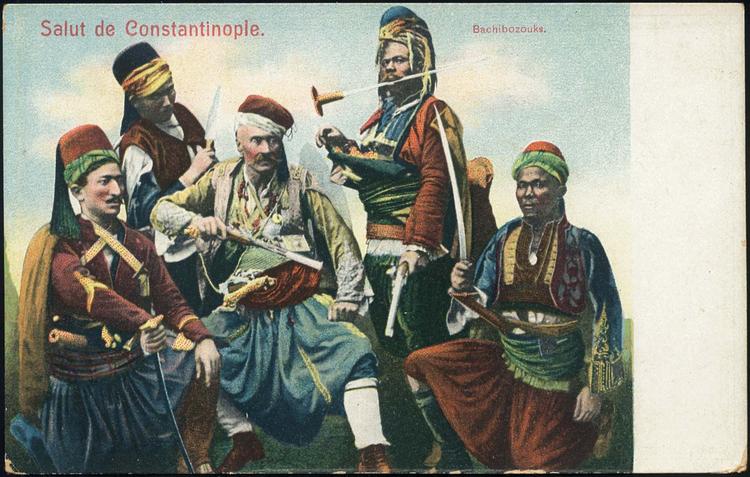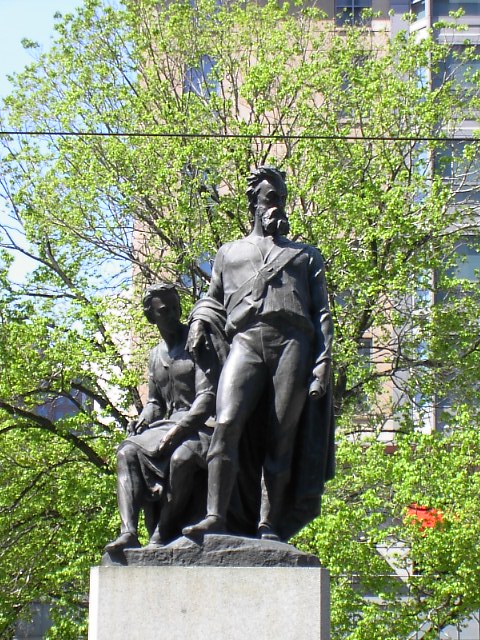|
Gustavus Von Tempsky
Gustavus Ferdinand von Tempsky (15 February 1828 – 7 September 1868) was a Prussian adventurer, artist, newspaper correspondent and soldier in New Zealand, Australia, California, Mexico and the Mosquito Coast of Central America. He was also an amateur watercolourist who painted the New Zealand bush and the military campaign. Early life Gustav Ferdinand von Tempsky was born in Braunsberg, East Prussia, into a Prussian noble family. The family had branches in Silesia and elsewhere and had a long military tradition. Von Tempsky was brought up in Liegnitz in Lower Silesia. After this time, he was sent to a junior cadet school in Potsdam and then a cadet school in Berlin. He was a cousin of the German writer Valeska von Gallwitz. In 1844, he was commissioned into his father's regiment in the Royal Prussian Army, possibly the Garde-Fusilier Regiment in which his brother, Benno Waldemar von Tempsky was a second lieutenant. In 1846, tiring of the routine, von Tempsky left the reg ... [...More Info...] [...Related Items...] OR: [Wikipedia] [Google] [Baidu] |
Braniewo
Braniewo () (, , Old Prussian language, Old Prussian: ''Brus''), is a town in northern Poland, in Warmia, in the Warmian-Masurian Voivodeship, with a population of 16,907 as of June 2021. It is the capital of Braniewo County. Braniewo is the second biggest city of Warmia after Olsztyn and one of the historical centers of the region. Location Braniewo lies on the Pasłęka River about 5 km from the Vistula Lagoon, about 35 km northeast of Elbląg and southwest of Kaliningrad (). The Polish border with Russia's Kaliningrad Oblast lies 6 km north, and may be reached from Braniewo via National road 54 (Poland), National road 54. History Middle Ages According to the German geographer Johann Friedrich Goldbeck (1748–1812), the town originally was named Brunsberg after Bruno von Schauenburg (1205–1281), bishop of Olomouc in Moravia, who accompanied King Ottokar II of Bohemia in 1254 and 1267 when the latter participated in the crusade of the Teutonic Knights again ... [...More Info...] [...Related Items...] OR: [Wikipedia] [Google] [Baidu] |
Volunteer Force (New Zealand)
The Volunteer Force was a voluntary part time military organisation of the New Zealand Army, New Zealand Military Forces. The force provided the bulk of New Zealand's defence during the late nineteenth century and was made up of small independent corps of less than 100 men. Throughout its entire existence, the Volunteer Force was criticised for being untrained, disorganised and poorly led, with units often prioritising Full dress uniform, dress uniforms over actual military training. Despite these misgivings, units of the Volunteer Force did conduct military actions during the New Zealand Wars and the Second Boer War. In 1910 the Volunteer Force was converted into the Territorial Force. Many of the modern day units of the New Zealand Army can draw their lineages back to corps of the Volunteer Force. The New Zealand Wars During the 1830s and 1840s, European settlers formed a number of volunteer units throughout the North Island and in Nelson, New Zealand, Nelson in response to the f ... [...More Info...] [...Related Items...] OR: [Wikipedia] [Google] [Baidu] |
Irregular Military
Irregular military is any military component distinct from a country's regular armed forces, representing non-standard militant elements outside of conventional governmental backing. Irregular elements can consist of militias, private armies, mercenaries, or other non-state actors, though no single definition exists beyond exclusion from national service. Without standard military unit organization, various more general names are often used; such organizations may be called a ''troop'', ''group'', ''unit'', ''column'', ''band'', or ''force''. Irregulars are soldiers or warriors that are members of these organizations, or are members of special military units that employ irregular military tactics. This also applies to irregular infantry and irregular cavalry units. Irregular warfare is warfare employing the tactics commonly used by irregular military organizations. This often overlaps with asymmetrical warfare, avoiding large-scale combat and focusing on small, stealth ... [...More Info...] [...Related Items...] OR: [Wikipedia] [Google] [Baidu] |
British Subject
The term "British subject" has several different meanings depending on the time period. Before 1949, it referred to almost all subjects of the British Empire (including the United Kingdom, Dominions, and colonies, but excluding protectorates and protected states). Between 1949 and 1983, the term was synonymous with Commonwealth citizen. Currently, it refers to people possessing a class of British nationality largely granted under limited circumstances to those connected with Ireland or British India born before 1949. Individuals with this nationality are British nationals and Commonwealth citizens, but not British citizens. The status under the current definition does not automatically grant the holder right of abode in the United Kingdom but almost all British subjects do have this entitlement. As of 2025, about 20,400 British subjects hold valid British passports with this status and enjoy consular protection when travelling abroad; about 800 do not have right of abode ... [...More Info...] [...Related Items...] OR: [Wikipedia] [Google] [Baidu] |
William Jackson (New Zealand Politician)
William Jackson (11 October 1832 – 29 September 1889), generally known as Major Jackson, was a 19th-century Member of Parliament in the Waikato region of New Zealand. Early life Jackson was born in 1832 in Providence Green, Green Hammerton, near Harrogate, Yorkshire, England. He was the son of Samuel Jackson (1806–1858), a brewer and yeoman who owned and farmed his land, and Sarah Jackson (née Hughlings; 1807/08–1836), the daughter of a Welsh revenue collector. His mother died when he was four. He had three brothers and a sister; all but one of the brothers emigrated to New Zealand. His parents had married on 24 March 1828. His oldest sibling was his sister Ann (30 April 1829 – 9 August 1859). She died three days after giving birth to her first child. His eldest brother was Samuel, who studied law, was called to the bar in 1853, and emigrated to Auckland in 1856, where he became a prominent lawyer. William himself was the third of the children; he was born on 11 Octob ... [...More Info...] [...Related Items...] OR: [Wikipedia] [Google] [Baidu] |
The Daily Southern Cross
''The New Zealand Herald'' is a daily newspaper published in Auckland, New Zealand, owned by New Zealand Media and Entertainment, and considered a newspaper of record for New Zealand. It has the largest newspaper circulation in New Zealand, peaking at over 200,000 copies in 2006, although circulation of the daily ''Herald'' had declined to 100,073 copies on average by September 2019. The ''Herald''s publications include a daily paper; the ''Weekend Herald'', a weekly Saturday paper; and the ''Herald on Sunday'', which has 365,000 readers nationwide. The ''Herald on Sunday'' is the most widely read Sunday paper in New Zealand. The paper's website, nzherald.co.nz, is viewed 2.2 million times a week and was named Voyager Media Awards' News Website of the Year in 2020, 2021, 2022, and 2023. In 2023, the ''Weekend Herald'' was awarded Weekly Newspaper of the Year and the publication's mobile application was the News App of the Year. Its main circulation area is the Auckland r ... [...More Info...] [...Related Items...] OR: [Wikipedia] [Google] [Baidu] |
Auckland
Auckland ( ; ) is a large metropolitan city in the North Island of New Zealand. It has an urban population of about It is located in the greater Auckland Region, the area governed by Auckland Council, which includes outlying rural areas and the islands of the Hauraki Gulf, and which has a total population of as of It is the List of cities in New Zealand, most populous city of New Zealand and the List of cities in Oceania by population, fifth-largest city in Oceania. The city lies between the Hauraki Gulf to the east, the Hunua Ranges to the south-east, the Manukau Harbour to the south-west, and the Waitākere Ranges and smaller ranges to the west and north-west. The surrounding hills are covered in rainforest and the landscape is dotted with 53 volcanic centres that make up the Auckland Volcanic Field. The central part of the urban area occupies a narrow isthmus between the Manukau Harbour on the Tasman Sea and the Waitematā Harbour on the Pacific Ocean. Auckland is one of ... [...More Info...] [...Related Items...] OR: [Wikipedia] [Google] [Baidu] |
Drury, New Zealand
Drury is a rural town near Auckland, in northern New Zealand. Located 36 kilometres to the south of Auckland CBD, under authority of the Auckland Council. Drury lies at the southern border of the Auckland metropolitan area, 12 kilometres to the northeast of Pukekohe, close to the Papakura Channel, an arm of the Manukau Harbour. Name Drury is named after Commander Byron Drury, captain of HMS ''Pandora'', who surveyed the Manukau Harbour in 1853. History Coal mining was a significant early industry established in Drury during the 1850s, and saw the formation of the Waihoihoi Mining and Coal Company in 1859. Continued success with coal mining led to the opening of one of New Zealand's earliest tramways by the company in 1862, consisting of 4ft 8in gauge track with a length of 5.2km, whereby coal was transported to Slippery Creek for shipment to Onehunga. Another early industry seen in Drury was that of an extensive brick and pottery works, linked to a nearby quarry by a tram ... [...More Info...] [...Related Items...] OR: [Wikipedia] [Google] [Baidu] |
Invasion Of The Waikato
The invasion of the Waikato became the largest and most important campaign of the 19th-century New Zealand Wars. Hostilities took place in the North Island of New Zealand between the military forces of the colonial government and a federation of Māori tribes known as the Kingitanga Movement. The Waikato is a territorial region with a northern boundary somewhat south of the present-day city of Auckland. The campaign lasted for nine months, from July 1863 to April 1864. The invasion was aimed at crushing Kingite power (which European settlers saw as a threat to colonial authority) and also at driving Waikato Māori from their territory in readiness for occupation and settlement by European colonists. The campaign was fought by a peak of about 14,000 Imperial and colonial troops and about 4,000 Māori warriors drawn from more than half the major North Island tribal groups. Plans for the invasion were drawn up at the close of the First Taranaki War in 1861 but the Colonial Of ... [...More Info...] [...Related Items...] OR: [Wikipedia] [Google] [Baidu] |
Coromandel Peninsula
The Coromandel Peninsula () on the North Island of New Zealand extends north from the western end of the Bay of Plenty, forming a natural barrier protecting the Hauraki Gulf and the Firth of Thames in the west from the Pacific Ocean to the east. It is wide at its broadest point. Almost its entire population lives on the narrow coastal strips fronting the Hauraki Gulf and the Bay of Plenty. In clear weather the peninsula is clearly visible from Auckland, the country's biggest city, which lies on the far shore of the Hauraki Gulf, to the west. The peninsula is part of the Thames-Coromandel District and the Waikato Region. Names The Māori name for the peninsula is ''Te Tara-o-te-Ika-a-Māui'', meaning "the barb of Māui's fish". This comes from the legend of Māui and the Fish, in which the demigod uses his hook to catch a great fish (Te Ika-a-Māui or the North Island) from the depths of the Pacific Ocean. In Hauraki Māori tradition, the fish is likened to a sti ... [...More Info...] [...Related Items...] OR: [Wikipedia] [Google] [Baidu] |
Robert O'Hara Burke
Robert O'Hara Burke (6 May 1821c. 28 June 1861) was an Irish soldier and police officer who achieved fame as an Australian explorer. He was the leader of the ill-fated Burke and Wills expedition, which was the first expedition to cross Australia from south to north, finding a route across the continent from the settled areas of Victoria to the Gulf of Carpentaria. The expedition party was well equipped, but Burke was not experienced in bushcraft. A Commission of Inquiry held by the Government of Victoria to investigate the failure of the expedition was a censure of Burke's judgement. Early years Burke was born in St Clerans, near the village of Craughwell, County Galway, Ireland in May 1821. He was the second of three sons of James Hardiman Burke (1788 – January 1854), an officer in the British army 7th Royal Fusiliers, and Anne Louisa Burke ''née'' O'Hara (married 1817, d.1844). Robert O'Hara was one of seven children: * John Hardiman Burke (d. August 1863) * Robert O' ... [...More Info...] [...Related Items...] OR: [Wikipedia] [Google] [Baidu] |






